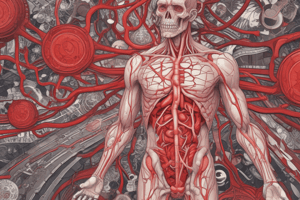Podcast
Questions and Answers
Which of the following is NOT a key goal of physiology research?
Which of the following is NOT a key goal of physiology research?
- Understanding disease mechanisms
- Improving human health and well-being
- Classifying organisms based on their evolutionary relationships (correct)
- Developing new therapies
Which of the following is NOT a component of blood plasma?
Which of the following is NOT a component of blood plasma?
- Red blood cells (correct)
- Water
- Electrolytes
- Proteins
What is the primary function of erythrocytes (red blood cells)?
What is the primary function of erythrocytes (red blood cells)?
- Fighting infection and disease
- Initiating blood clotting
- Carrying oxygen throughout the body (correct)
- Producing antibodies
Which of the following is a function of leukocytes (white blood cells) in the immune system?
Which of the following is a function of leukocytes (white blood cells) in the immune system?
Which of the following is a direct consequence of blood clotting?
Which of the following is a direct consequence of blood clotting?
What is the relationship between blood viscosity and its flow through blood vessels?
What is the relationship between blood viscosity and its flow through blood vessels?
How does blood pressure contribute to the delivery of blood to tissues?
How does blood pressure contribute to the delivery of blood to tissues?
What determines a person's blood type?
What determines a person's blood type?
Flashcards
Physiology
Physiology
The study of how living organisms function, examining processes from molecular to organismal levels.
Blood Composition
Blood Composition
Blood is composed of plasma and formed elements like red blood cells, white blood cells, and platelets.
Plasma
Plasma
The liquid portion of blood, containing water, proteins, electrolytes, nutrients, and waste products.
Erythrocytes
Erythrocytes
Signup and view all the flashcards
Leukocytes
Leukocytes
Signup and view all the flashcards
Thrombocytes
Thrombocytes
Signup and view all the flashcards
Blood Functions
Blood Functions
Signup and view all the flashcards
Blood Pressure
Blood Pressure
Signup and view all the flashcards
Study Notes
Introduction to Physiology
- Physiology studies how living organisms function, examining physical and chemical processes from molecular to organismal levels.
- It's an interdisciplinary field drawing knowledge from chemistry, physics, biology, and anatomy.
- It encompasses organ systems and their interactions, including the nervous, endocrine, cardiovascular, respiratory, and digestive systems.
- Physiology research aims to understand disease, develop therapies, and improve human health.
Blood
- Blood is a specialized connective tissue circulating throughout the body.
- It consists of:
- Plasma: a liquid portion containing water, proteins (albumins, globulins, fibrinogen), electrolytes, nutrients, and waste products.
- Formed elements: cells and fragments suspended in plasma, including:
- Erythrocytes (red blood cells): carry oxygen using hemoglobin, a protein that binds and transports oxygen. Their biconcave shape maximizes gas exchange surface area.
- Leukocytes (white blood cells): part of the immune system, fighting infection and disease. Different leukocytes have diverse functions like phagocytosis and antibody production.
- Thrombocytes (platelets): cell fragments initiating blood clotting by releasing factors for the clotting cascade.
- Blood functions include:
- Transporting gases (oxygen and carbon dioxide), nutrients, hormones, and waste products.
- Regulating body temperature, pH, and fluid balance.
- Providing disease protection through the immune system, including phagocytosis and antibody creation.
- Blood clotting, the process of forming clots to prevent bleeding.
- Blood volume and composition are carefully regulated for homeostasis. Variations can cause health issues.
- Blood characteristics like viscosity, pH, and osmotic pressure are crucial for function.
- Blood pressure, driven by the heart's pumping, delivers blood to tissues. Maintaining healthy blood pressure is key for preventing health complications.
- Blood types are determined by specific antigens on red blood cell surfaces. Matching blood types is vital for transfusions to avoid lethal reactions.
- Blood disorders such as anemia, leukemia, and hemophilia can impact blood component function and overall health.
Studying That Suits You
Use AI to generate personalized quizzes and flashcards to suit your learning preferences.





